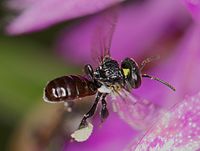
Nosema ceranae in South American Native Stingless Bees and Social Wasp
Sign Up to like & getrecommendations! Published in 2017 at "Microbial Ecology"
DOI: 10.1007/s00248-017-0975-1
Abstract: Besides the incipient research effort, the role of parasites as drivers of the reduction affecting pollinator populations is mostly unknown. Given the worldwide extension of the beekeeping practice and the diversity of pathogens affecting Apis… read more here.
Keywords: social wasp; nosema ceranae; stingless bees;

Immunity and physiological changes in adult honey bees (Apis mellifera) infected with Nosema ceranae: the natural colony environment.
Sign Up to like & getrecommendations! Published in 2021 at "Journal of insect physiology"
DOI: 10.1016/j.jinsphys.2021.104237
Abstract: Nosema ceranae is a microsporidium that infects Apis mellifera, causing diverse physiological and behavioral alterations. Given the existence of individual and social mechanisms to reduce infection and fungal spread in the colony, bees may respond… read more here.
Keywords: apis mellifera; colony; honey; colony environment ... See more keywords

Proteomics and Immune Response Differences in Apis mellifera and Apis cerana Inoculated with Three Nosema ceranae Isolates.
Sign Up to like & getrecommendations! Published in 2023 at "Journal of proteome research"
DOI: 10.1021/acs.jproteome.3c00095
Abstract: Nosema ceranae infects midgut epithelial cells of the Apis species and has jumped from its original host A. cerana to A. mellifera worldwide, raising questions about the response of the new host. We compared the… read more here.
Keywords: nosema ceranae; cerana; mellifera; response ... See more keywords

Nosema ceranae in Apis mellifera: a 12 years postdetection perspective.
Sign Up to like & getrecommendations! Published in 2018 at "Environmental microbiology"
DOI: 10.1111/1462-2920.14103
Abstract: Nosema ceranae is a hot topic in honey bee health as reflected by numerous papers published every year. This review presents an update of the knowledge generated in the last 12 years in the field… read more here.
Keywords: mellifera years; apis mellifera; years postdetection; nosema ceranae ... See more keywords

Nosema ceranae (Microsporidia: Nosematidae) Does Not Cause Collapse of Colonies of Africanized Apis mellifera (Hymenoptera: Apidae) in Tropical Climate
Sign Up to like & getrecommendations! Published in 2020 at "Sociobiology"
DOI: 10.13102/sociobiology.v67i3.4950
Abstract: Nosemosis is an important disease that affects honey bees (Apis mellifera Lineu), caused by obligate intracellular parasites, Nosema apis and/or Nosema ceranae. Since the initial detection of N. ceranae in A. mellifera coincided with recent… read more here.
Keywords: apis mellifera; infection; nosema ceranae;

Spillover and genome selection of the gut parasite Nosema ceranae between honey bee species
Sign Up to like & getrecommendations! Published in 2022 at "Frontiers in Cellular and Infection Microbiology"
DOI: 10.3389/fcimb.2022.1026154
Abstract: Nosema ceranae is a honey bee gut parasite that has recently spilled to another honey bee host through trading. The impact of infection on the native host is minor, which is substantial in the novel… read more here.
Keywords: novel host; host; honey bee; nosema ceranae ... See more keywords

Scientific Advances in Controlling Nosema ceranae (Microsporidia) Infections in Honey Bees (Apis mellifera)
Sign Up to like & getrecommendations! Published in 2019 at "Frontiers in Veterinary Science"
DOI: 10.3389/fvets.2019.00079
Abstract: Honey bees (Apis mellifera) are agriculturally important pollinators that have been recently at risk to severe colony losses. A variety of parasites and pathogens have been linked to colony decline, including the microsporidian parasite Nosema… read more here.
Keywords: apis mellifera; scientific advances; advances controlling; nosema ceranae ... See more keywords

Use of Thymol in Nosema ceranae Control and Health Improvement of Infected Honey Bees
Sign Up to like & getrecommendations! Published in 2022 at "Insects"
DOI: 10.3390/insects13070574
Abstract: Simple Summary In the European Union, there is no registered product for the control of the honey bee endoparasite Nosema ceranae. Thus, researchers are looking for options for Nosema treatment. The aim of this study… read more here.
Keywords: health; honey; honey bees; nosema ceranae ... See more keywords

Epidemiology of the Microsporidium Nosema ceranae in Four Mediterranean Countries
Sign Up to like & getrecommendations! Published in 2022 at "Insects"
DOI: 10.3390/insects13090844
Abstract: Simple Summary Nosema ceranae is a highly prevalent intracellular parasite of honey bees’ midgut worldwide. There is a lack of studies addressing the influence of climatic and beekeeping factors on the dynamics of its infection.… read more here.
Keywords: honey; france; nosema ceranae; infection ... See more keywords

The Role of Nosema ceranae (Microsporidia: Nosematidae) in Honey Bee Colony Losses and Current Insights on Treatment
Sign Up to like & getrecommendations! Published in 2022 at "Veterinary Sciences"
DOI: 10.3390/vetsci9030130
Abstract: Honeybee populations have locally and temporally declined in the last few years because of both biotic and abiotic factors. Among the latter, one of the most important reasons is infection by the microsporidia Nosema ceranae,… read more here.
Keywords: honey; nosema ceranae; role nosema; bee ... See more keywords